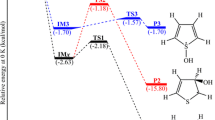Abstract
The Gif systems for the selective functionalization of saturated hydrocarbons based on the reactions of Superoxide with FeII and of hydrogen peroxide with FeIII are described. Both systems are relatively efficient, but not nearly so efficient as the electrochemical system developed in collaboration with Prof. G. Balavoine and Dr. Aurore Gref (Université de Paris-Sud-Orsay, France). All of the systems afford mainly ketones. This is an unusual selectivity, which implies a non-radical mechanism. It has been proven for the FeIII-H2O2 system that the activation of the FeIII is independent of the formation of ketone, which involves a hydroperoxide (derived from oxygen) as an intermediate. This intermediate controls the formation of ketone and of secondary alcohol. The addition of a number of trapping reagents such as BrCCl3 diverts the reaction from oxygenation to bromide formation. Although BrCCl3 is indeed a good trap for carbon radicals, the pattern of selectivity across a range of saturated hydrocarbons is completely different for Gif chemistry when compared with normal radical bromination. The chemistry is explained in terms of an FeV oxenoid species that inserts itself into secondary C-H bonds (a compromise between bond strength and steric hindrance). This gives an FeV intermediateA with an iron-carbon bond, which is probably rapidly reduced to the FeIII state by hydrogen peroxide. Then oxygen is inserted into the FeIII-C bond. Hydrolysis affords the isolateable intermediate hydroperoxide (intermediateB). A system based ontert-butyl hydroperoxide (TBHP) is described. This is similar to the above Gif systems, but the kinetic isotope effect is very different and the selectivity for adamantane substitution is different. However, FeIII is activated by TBHP to an FeV oxenoid which, after reaction with a hydrocarbon, reacts with oxygen to give a hydroperoxide. So the pattern of intermediatesA andB is maintained with TBHP. Radical chemistry is involved in some of the reactions that involve ionic coupling to saturated hydrocarbons. The importance of the FeII-FeIV manifold in providing a mechanism that permits the selective functionalization of saturated hydrocarbons by ionic trapping with chloride, azide, and other anions is made manifest. Comparison is made with the FeIII-FeV manifold where ionic trapping is never seen. Traditional Fenton chemistry (hydroxyl radical formation) is not operative here, but the trapping does involve the formation of carbon radicals. These react very efficiently with anions bonded to FeIII.
Similar content being viewed by others
References
D. H. R. Barton, M. J. Gastiger, and W. B. Motherwell,J. Chem. Soc., Chem. Commun., 1983, 41.
D. H. R. Barton, F. Halley, N. Ozbalik, M. Schmitt, E. Young, and G. Balavoine,J. Am. Chem. Soc., 1989,111, 7144.
D. H. R. Barton, S. D. Bévière, and D. Doller,Tetrahedron Lett., 1991,32, 4671.
D. H. R. Barton, S. D. Bévière, W. Chavasiri, E. Csuhai, D. Doller, and W.-G. Liu,J. Am. Chem. Soc., 1992,114, 2147.
D. H. R. Barton, E. Csuhai, and D. Doller,Tetrahedron, 1992,48, 9195.
D. H. R. Barton, S. D. Bévière, W. Chavasiri, E. Csuhai, and D. Doller,Tetrahedron, 1992,48, 2895.
G. Balavoine, D. H. R. Barton, J. Boivin, A. Gref, P. Le Coupanec, N. Ozbalik, J. A. X. Pestana, and H. Rivière,Tetrahedron, 1988,44, 1091.
D. H. R. Barton, S. D. Bévière, W. Chavasiri, D. Doller, and B. Hu,Tetrahedron Lett., 1992,33, 5473.
D. H. R. Barton and W. Chavasiri,Tetrahedron, 1994,50, 19.
D. H. R. Barton, S. D. Bévière, and W. Chavasiri,Tetrahedron, 1994,50, 31.
D. H. R. Barton and W. Chavasiri,Tetrahedron, 1994,50, 47.
D. H. R. Barton and T.-L. Wang,Tetrahedron, 1994,50, 1011.
F. Minisci and F. Fontana,Tetrahedron Lett., 1994,35, 1427.
F. Minisci, F. Fontana, S. Araneo, and F. Recupeno,Tetrahedron Lett., 1994 (in press).
C. Sheu, A. Sobkowiak, L. Zhang, N. Ozbalik, D. H. R. Barton, and D. T. Sawyer,J. Am. Chem. Soc., 1989,111, 8030.
C. Sheu, S. A. Richert, P. Cofré, B. Ross, Jr. A. Sobkowiak, D. T. Sawyer, and J. R. Kanofsky,J. Am. Chem. Soc., 1990,112, 1936.
C. Sheu and D. T. Sawyer,J. Am. Chem. Soc., 1990,112, 8212.
H.-C. Tung, C. Kang, and D. T. Sawyer,J. Am. Chem. Soc., 1992,114, 3445.
U. Schuchardt, W. A. Carvalho, and E. V. Spinacé,Synlett, 1993, 713.
U. Schuchardt, C. E. Z. Krähembühl, and W. A. Carvalho,New J. Chem., 1991,15, 955.
T. Briffaud, C. Larpent, and H. Patin,J. Chem. Soc., Chem. Commun., 1990, 1193.
C. Larpent and H. Patin,J. Mol. Catal., 1992,72, 315.
D. H. R. Barton and S. D. Bévière,Tetrahedron Lett., 1993,34, 5689.
D. H. R. Barton, S. D. Bévière, W. Chavasiri, D. Doller, and B. Hu,Tetrahedron Lett., 1993,34, 1871.
G. H. Kruppa and J. L. Beauchamp,J. Am. Chem. Soc., 1986,108, 2162; J. C. Walton,Chem. Soc. Rev., 1992, 105; I. Tabushi, J. Hamuro, and R. Oda,J. Am. Chem. Soc., 1967,89, 7127.
J. K. Kochi,Free Radicals, John Wiley and Sons, Inc., New York, 1973.
D. T. Sawyer, C. Kang, A. Llobet, and C. Redman,J. Am. Chem. Soc., 1993,115, 5817 (and references therein).
D. H. R. Barton and D. Doller,Acc. Chem. Res., 1992,25, 504.
I. Yamazaki and L. H. Piette,J. Am. Chem. Soc., 1991,113, 7588.
P. D. Bartlett, E. P. Benzing, and R. E. Pincock,J. Am. Chem. Soc., 1960,82, 1762.
W. A. Pryor, D. L. Fuller, and J. P. Stanley,J. Am. Chem. Soc., 1972,94, 1632.
L. J. Clark,Anal. Chem., 1962,34, 348.
Author information
Authors and Affiliations
Additional information
D. R. H. Barton is a Nobel Prize winner in chemistry in 1969. Since 1994, he is a foreign member of the Russian Academy of Sciences.
Translated fromIzvestiya Akademii Nauk. Seriya Khimicheskaya, No. 4, pp. 595–604, April, 1995.
We thank all our colleagues cited in the various References for their contributions to this fascinating subject. We also thank Prof. Minisci for his helpful comments. This work was supported by Quest Intl. and by the Welch Foundation.
Rights and permissions
About this article
Cite this article
Barton, D.H.R., Taylor, D.K. The FeII-FeIV and FeIII-FeV manifolds in an expanded world of Gif chemistry. Russ Chem Bull 44, 575–583 (1995). https://doi.org/10.1007/BF00698484
Received:
Issue Date:
DOI: https://doi.org/10.1007/BF00698484




